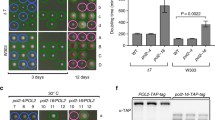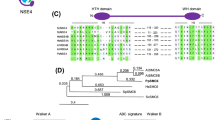Abstract
We have evaluated the effect of the Saccharomyces cerevisiae pso4-1 mutation in sporulation and DNA repair during meiosis. We have found that pso4-1 cells were arrested in an early step of meiosis, before premeiotic DNA synthesis, and hence did not produce spores. These results suggest that the PSO4 gene may act at the start point of the cell cycle, as do some SPO and CDC genes. The pso4-1 mutant cells are specifically sensitive to 8-MOP- and 3-CPs-photoinduced lesions, and are found to be severely affected in meiotic recombination as well as impaired in the mutagenic response, as previously described for mitosis. This means that the PSO4 gene is important for the repair 8-MOP-photoinduced lesions, mainly double-strand breaks, and the processing of these lesions into recombinogenic intermediates.
Similar content being viewed by others
References
Alani E, Padmore R, Kleckner N (1990) Analysis of wild-type and rad50 mutants of yeast suggests an intimate relationship between meiotic chromosome synapsis and recombination. Cell 61:419–436
Andrade HHR, Marques EK, Schenberg ACG, Henriques JAP (1989) The PSO4 gene is responsible for an error-prone recombinational DNA repair pathway in Saccharomyces cerevisiae Mol Gen Genet 217:419–426
Averbeck D (1989) Recent advances in the psoralen phototoxicity mechanism. Photochem Photobiol 50:859–882
Cao L, Alani E, Kleckner N (1990) A pathwas for generation and processing of double-strand breaks during meiotic recombination in S. cerevisiae. Cell 61:1081–1101
Cassier-Chauvat C, Moustacchi E (1988) Allelism between pso1-1 and rev3-1 mutants and between pso2-1 and smn1 mutants of Saccharomyces cerevisiae. Curr Genet 13:37–40
Esposito RE, Klapholtz S (1981) Meiosis and ascospore development. In: Strathern JN, Jones EW, Broach JR (eds) The molecular biology of the yeast Saccharomyces, cell cycle and inheritance. Cold Spring Harbor Laboratory, Cold Spring Harbor, New York, pp. 211–287
Henriques JAP, Brendel M (1990) The role of PSO and SNM genes in DNA repair of the yeast S. cerevisiae Curr Genet 18:387–393
Henriques JAP, Vicente EJ, Da Silva KVCL, Schenberg ACG (1989) PSO4: a novel gene involved in error-prone repair in Saccharomyces cerevisiae Mutat Res 281:111–124
Holliday R (1964) A mechanism for gene conversion in fungi. Genet Res 5:282–304
Jachymczyk WJ, von Bostel RC, Mowat MRA, Hastings PJ (1981) Repair of interstrand cross-links in DNA of Saccharomyces cerevisiae requires two systems of DNA repair: the RAD3 system and the RAD51 system. Mol Gen Genet 182:196–205
Kelly SL, Merill C, Parry JM (1983) Cyclic variation in sensitivity to X-irradiation during meiosis in Saccharomyces cerevisiae Mol Gen Genet 191:314–318
Machida I, Nakai S (1980a) Induction of spontaneous and UV-induced mutations during commitment to meiosis in Saccharomyces cerevisiae. Mutat Res 73:59–68
Machida I, Nakai S (1980b) Differential effect of UV irradiation on induction of intragenic and intergenic recombination during commitment to meiosis in Saccharomyces cerevisiae Mutat Res 73:69–79
Madura K, Prakash S, Prakash L (1990) Expression of the Saccharomyces cerevisiae DNA repair gene RAD6 that encodes a ubiquitin-conjugating enzyme, increases in response to DNA damage and in meiosis but remains constant during the mitotic cell cycle. Nucleic Acids Res 18:771–779
Magaña-Schwencke N, Henriques JAP, Chanet R, Moustacchi E (1982) The fate of 8-methoxypsoralen-photoinduced cross-links in nuclear and mitocondrial yeast DNA: comparison of wild-type and repair-deficient strains. Proc Natl Acad Sci USA 79:1722–1726
Meira LB, Fonseca MB, Averbeck D, Schenberg ACG, Henriques JAP (1992) The pso4-1 mutation reduces spontaneous mitotic gene conversion and reciprocal recombination in Saccharomyces cerevisiae Mol Gen Genet 239:311–316
Meselson MS, Radding CM (1975) A general model for genetic recombination. Proc Natl Acad Sci USA 72:358–361
Moens PB (1982) Mutants of yeast meiosis Saccharomyces cerevisiae. Can J Genet Cytol 24:243–253
Morais Jr MA, Brozmanova J, Benfato M, Duraj J, Vlckova V, Henriques JAP (1994) The E. coli recA gene can restore the defect in mutagenesis of the pso4-1 mutant of S. cerevisiae Mutat Res 314:209–220
Orr-Weaver TL, Szostak JW (1985) Fungal recombination. Microbiol Rev 49:33–58
Petes TD, Malone RE, Symington LS (1991) Recombination in yeast. In: The molecular and cellular biology of the yeast Saccharomyces: genome dynamics, protein synthesis and energetics. Cold Spring Harbor Laboratory, Cold Spring Harbor, New York, pp 407–521
Pothin HS, Da Silva KVCL Brendel M, Henriques JAP (1994) Genetic effects of photoactivated psoralens during meiosis in the DNA repair mutant pso3-1 of Saccharomyces cerevisiae Curr Genet 25:19–23
Resnick MA (1987) Investigating the genetic control of biochemical events in meiotic recombination. In: Moens PB Meiosis. Academic Press, New York, pp 157–210
Resnick MA, Martin P (1976) The repair of double-strand breaks in nuclear DNA of Saccharomyces cerevisiae and its genetic control. Mol Gen Genet 143:119–129
Resnick MA, Stasiewicz S, Game JC (1983a), Meiotic DNA metabolism in wild-type and excision-deficient yeast following UV exposure. Genetics 104:583–601
Resnick MA, Game JC, Stasiewicz S (1983b), Genetic effects of UV irradiation on excision-proficient and-deficient yeast during meiosis. Genetics 104:603–618
Roman H (1984) A comparison of induced and spontaneous gene conversion in mitotic and meiotic cells of Saccharomyces cerevisiae. Carlsberg Res Commun 49:351–358
Sage E, Doan TC, Boyer V, Helland DE, Kittler L, Helene C, Moustacchi E (1989) Oxidative DNA damage photoinduced by 3-carbethoxypsoralen and other furocumarins: mechanism of photo-oxidation and recognition by repair enzymes. J Mol Biol 209:297–314
Silva KVCL, Andrade HHR, Henriques JAP (1990) Mutational response of a diploid pso4-1 yeast strain defective in error-prone recombinational DNA repair. Rev Brasil Genet 19:393–408
Smith LM, Robbins LG, Kennedy A, Magee PT (1988) Identification and characterization of mutations affecting sporulation in Saccharomyces cerevisiae Genetics 120:899–907
Thorne LW, Byers B (1993) Stage-specific effects of X-irradiation on yeast meiosis. Genetics 134:29–42
Vicente EJ (1990) Identificação e caracterização de uma nova via de reparação do DNA na levedura Saccharomyces cerevisiae. PhD thesis, University of São Paulo, São Paulo SP
Author information
Authors and Affiliations
Additional information
Communicated by K. Wolf
Rights and permissions
About this article
Cite this article
da Silva, K.V.C.L., de Morais, M.A. & Henriques, J.A.P. The PSO4 gene of S. cerevisiae is important for sporulation and the meiotic DNA repair of photoactivated psoralen lesions. Curr Genet 27, 207–212 (1995). https://doi.org/10.1007/BF00326150
Received:
Issue Date:
DOI: https://doi.org/10.1007/BF00326150




